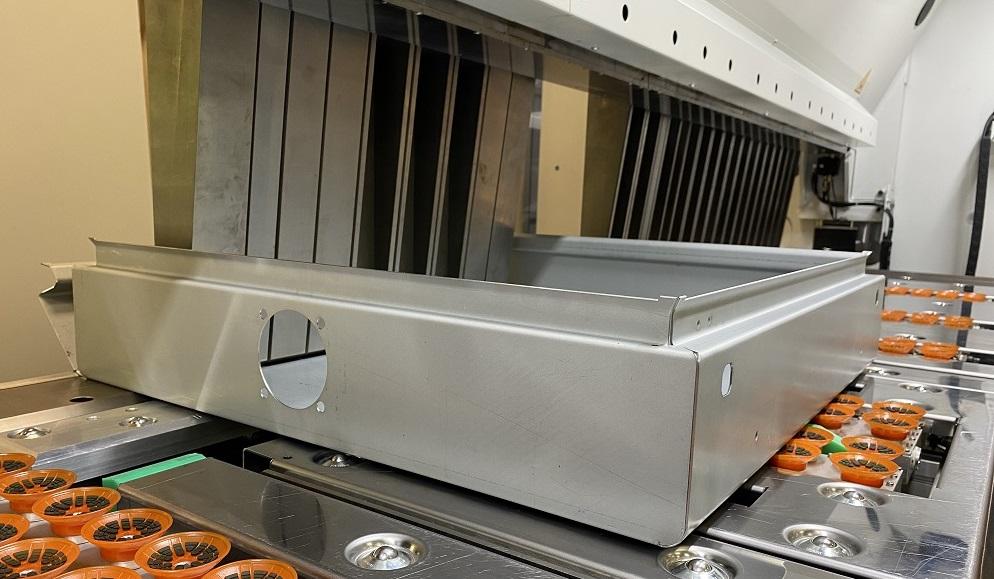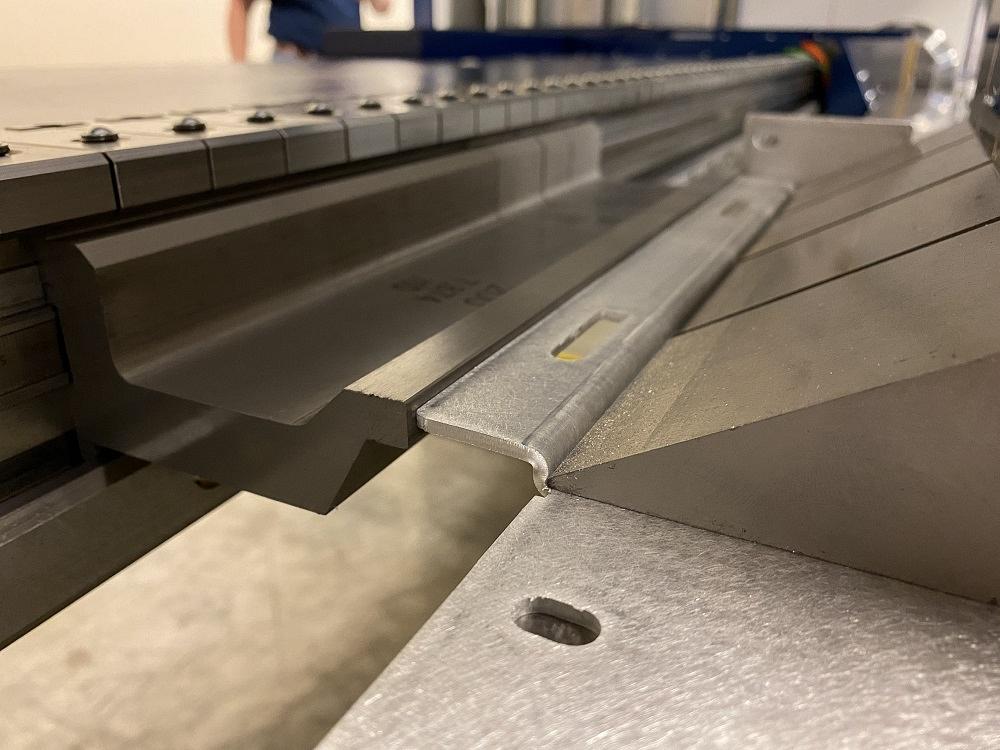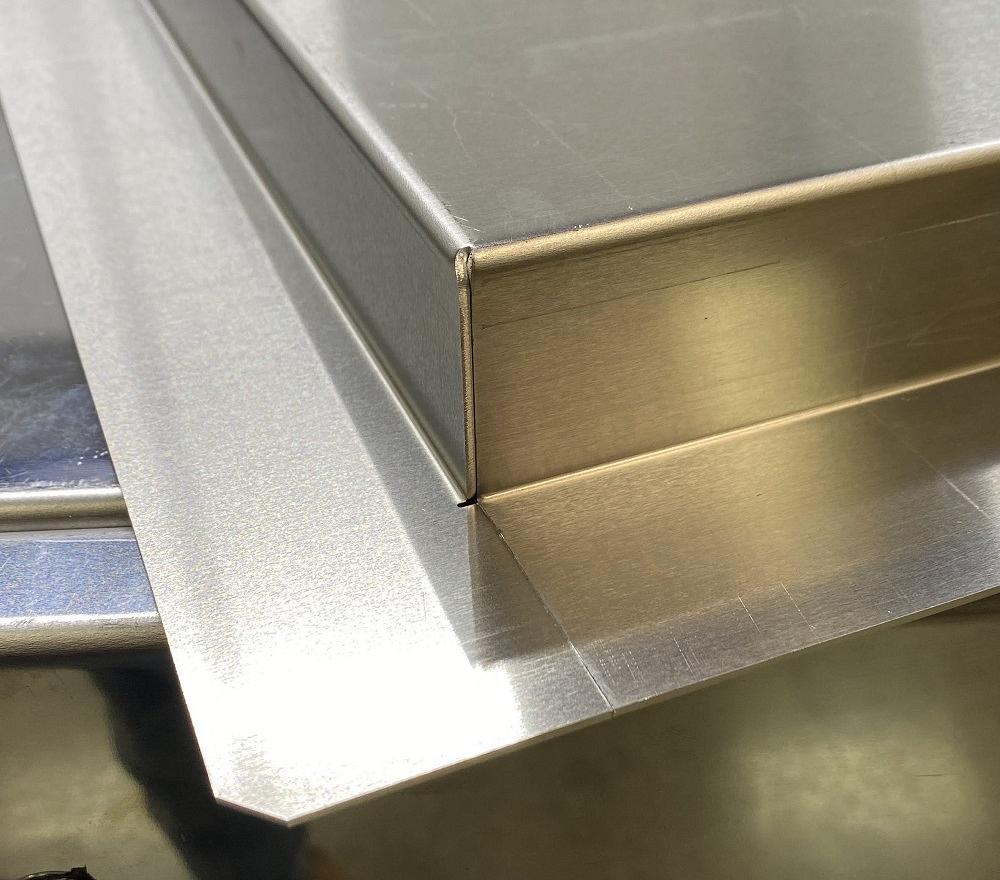Executive Vice President
- FMA
- The Fabricator
- FABTECH
- Canadian Metalworking
Categories
- Additive Manufacturing
- Aluminum Welding
- Arc Welding
- Assembly and Joining
- Automation and Robotics
- Bending and Forming
- Consumables
- Cutting and Weld Prep
- Electric Vehicles
- En Español
- Finishing
- Hydroforming
- Laser Cutting
- Laser Welding
- Machining
- Manufacturing Software
- Materials Handling
- Metals/Materials
- Oxyfuel Cutting
- Plasma Cutting
- Power Tools
- Punching and Other Holemaking
- Roll Forming
- Safety
- Sawing
- Shearing
- Shop Management
- Testing and Measuring
- Tube and Pipe Fabrication
- Tube and Pipe Production
- Waterjet Cutting
Industry Directory
Webcasts
Podcasts
FAB 40
Advertise
Subscribe
Account Login
Search
Folding technology finds its place in the modern job shop
Manufacturing realities force fabricators to consider a new approach to forming parts
- By David Prokop
- July 6, 2022
- Article
- Bending and Forming

This electronics enclosure will be laser-welded in a downstream operation once it leaves the folding machine. It features bump-formed radius corners.
Because of current challenges, metal fabricators are looking at folding machines in an entirely different light than they did only five years ago.
Long embraced by the architectural fabrication companies, folding technology also has made inroads into the precision sheet metal market over the last decade. The attraction was the folding machine’s ability to process large, unwieldy parts, the kind that would require two or three people to process on a press brake.
The design of the folding machine is perfect for these parts. An operator places the large piece of sheet metal on the sheet support table and backgauge and moves it against the stop, and the vacuum gauge system grabs the part to start the forming sequence. At that point, a coordinated process begins: The vacuum gauge moves the sheet metal, the clamping beam holds the sheet metal in place, and the folding beam makes the forms in an upward or downward movement. The machine automatically adjusts the position of the folding beam and pivot point between bends, adjusting for proper radius, crown, and flange length. The operator doesn’t have to touch the sheet metal part again until it needs to be rotated to continue the job or removed from the machine. One operator does the job that used to occupy multiple operators, with a significant increase in output.
These awkward-to-handle parts are still a good reason to purchase a folding machine, but the motivations are now much more than that. Metal fabricating companies are finding that folding machines are proving to be the right fit for today’s manufacturing realities.
About the Lack of Press Brake Operators
Most fab shops are looking for press brake operators. Because of the dearth of experienced operators, shops either have to steal them away from other companies or invest in training inexperienced individuals, which ironically makes them candidates to be stolen by another company down the line. A skilled operator is a rare commodity and a very valuable resource.
Thanks to the simplicity of a folding machine, the operator doesn’t need the experience of how to bend metal. The operator only needs to know how to run the machine. The folder takes care of the rest.
What about tooling changeovers? Typically an operator working on a folding machine is working with a single set of highly-flexible tools, able to bend any material type and thickness that the machine is rated for. Tools are arranged to the lengths required for the job, so that workpieces of different sizes can be formed. (Special tools, such as a tall clamping beam tool to handle deep part profiles, might be used in folding machine applications. But tool changes are still limited to adjusting the width of the clamping tools to fit the part size.)
For example, if an operator has just completed a job with a 72-in.-wide workpiece and is about to put a 36-in.-wide sheet on the machine, he needs to have a toolstation that is 36 in. wide. A certain portion of the clamping tools need to be moved aside to accommodate the new part length, which might take a couple of minutes. The operator typically never has to strip all of the tools from the machine as different jobs are done.
In those instances where changeovers are frequent and productivity is of the utmost importance, folding machines can be equipped with automatic tool changers. These mechanized grippers automatically arrange the clamping tools to accommodate the next job. These changes are done in seconds and occur while the operator is preparing for the next part run. This parallel process eliminates the downtime from tool change as other work is being performed during this time.
Experienced press brake operators are required to fabricate high-quality, complex parts on a consistent basis. With folding, less-experienced machine operators can make high-quality, complex parts after only a short amount of training.
The Shift Away From Batch Manufacturing
The one set of tooling and quick tooling changeovers associated with folding machines are important because they remove the main excuse for a company still committed to batch manufacturing. Operators no longer have the excuse of making more than is necessary for a job because a folding machine can move from one job to the next in a matter of a few minutes, not 30 to 60 minutes. A company with a folding machine is closer to one-piece flow in a shop.
What’s wrong with batch manufacturing? Because a shop doesn’t want set up a press brake to form five to 10 parts, it’ll make 50 of them with the knowledge that they’ll likely need them for a job later. But once they do that, the shop needs to store the unused parts, track them, and later retrieve them—if they can be found. Shops that practice this type of production are easy to identify because parts on pallets are located all over the shop floor, and more than likely operators can be seen looking on those pallets like a child looking for a four-leaf clover in a field. Valuable production time is also wasted making parts not needed until later rather than parts that are needed right now. Batch manufacturing doesn’t make for quicker production; it makes for more complicated manufacturing.
Folders can produce parts for downstream operations as they are needed. Kits, a collection of parts for one particular job or assembly, also can be prepared upon request. This keeps the shop floor free of work-in-process and provides a visual reminder of what’s next. It’s one way to tame the chaos associated with job shops.
Addressing Those Downstream Operations
The same fab shops struggling to find press brake operators also are having difficulty recruiting welders. There aren’t enough of those people willing to work in metal fabricating environments, forcing many businesses to jump into robotic welding. For those automated systems to work, the workpieces have to be formed with a high level of consistent accuracy so that fit-up meets welding specifications.
Again, that’s where folding machines can shine. Folding machines typically form bend angles to plus or minus a third of a degree or better. Moving the responsibility of part quality from the operator to the machine means the first part is going to have the same quality as the last part in the job.
Now consider forming a NEMA-rated enclosure on a press brake. This type of enclosure has 16 bends, four bends on each of the four sides. That means the brake operator has to gauge that workpiece 16 different times, flipping it repeatedly throughout the process. If any of those gauge points are missed, the mistake is going to compound itself with each subsequent form, resulting in a scrapped piece. Even worse, If that out-of-tolerance part is passed along to downstream operations, the cost of that bad part only multiplies. Keep in mind that the larger the part, the more difficult holding accuracy becomes.
The same part on a folding machine requires the machine operator to be engaged in the workpiece placement only four times—once per side, and never requires a flip. The opportunities for error are greatly reduced when compared to trying to do the same job on a press brake.
Because of the folding machine’s ability to deliver consistent, high-tolerance forms, the technology often is paired up with laser welding cells, which require absolute consistency in fit-up because the process doesn’t rely on a consumable like wire to fill the gap during the welding process. A laser welding torch melts the edges of formed sheet metal to create the seam, and the process requires exact gaps through the joint. (Generally in laser welding, the gap must be no more than 10% of the thickness of the sheet metal.)
Not only does repeatable part accuracy delivered by the folding machine simplify the use of robotic welding or allow for implementing laser welding, it can significantly reduce the system cost by simplifying the fixtures needed to hold the parts in position during traditional arc welding.
The Reality of Working With Surface-sensitive Materials
As metal fabricating work has gotten more competitive, some shops choose to pursue more complex work. This includes working with specialty materials that can’t be marred because of end-use applications. Consider stainless steel fabrications that are destined for high-end food service applications, for example.
Folding machines are able to deliver bends that don’t mar the surfaces of these surface-sensitive materials. The pressure applied to the workpiece to make the bends is distributed across a larger tool area, lessening the pressure points.
Contrast that with a press brake where the punch tip drives into the workpiece and the two edges of the die shoulders rub the bottom of the workpiece. Those contact points are where the press brake operator is going to find scuff marks, if some sort of vinyl isn’t being used to protect the workpiece’s surfaces.
And if vinyl is being used, someone eventually must remove it from the newly formed part. The vinyl is going to come off in three pieces—at the base of the part, the flange of the part, and the little strip in the middle where the die shoulders press through the protective material. The sticky residue that the vinyl left behind also will need to be cleaned off.
How much extra time is required to remove that protective covering and residue from each formed part? It might be only seconds, but that’s going to add up for each part over each shift over each day over each week. Seconds of nonvalue-added work add up over thousands of parts per year.
Better Bump Bending
Bump bending to create a radius on a sheet metal part is a specialty capability that some metal fabrication shops offer. Press brakes often are used to bend radii, either with a custom radius tool or by making shallow bends as the part is incrementally fed from bend to bend. This is an especially challenging task on a press brake and one requiring a great deal of skill and preparation, which is motivation enough for some shops to avoid these lucrative jobs.
A folding machine can create a radius form with little more effort than a sharp bend. The part is held by the vacuum gauge, and the folding beam locks into a shallow angle. As the part is fed forward, the beam clamps against the sheet making shallow incremental bends. The smoothness is determined by the feed increment, and the radius size is a combination of the number of increments and the angle of the folding beam. A radius on a folder is nothing more than a program, and no more challenging to produce than any other bend.
This type of form is produced quickly on a folding machine, is extremely repeatable, and eliminates the risk from those highly profitable jobs.
A Safer Machine Tool
For the most part, press brakes now are designed to keep even nonexperienced operators safe. Laser sensors ensure that fingers are kept clear of the pinch point, and ram control adjusts the bending speed to suit part size. Operators are less likely to suffer compression injuries than ever before.
Even with those improvements, press brakes still require manual part manipulation. Given that most experienced press brake operators are closer to retirement than their original start date of employment, that’s asking a lot from an individual operator—shift after shift, week after week. That’s a lot of wear and tear on shoulders and wrists.
Folding machines address those types of repetitive motion injuries by eliminating that type of part manipulation. Once loaded onto the gauge table, the part moves effortlessly on a bed of steel ball transfers. It takes little effort to roll the part against its gauge point so the vacuum gauge can take over and process the bends needed. Adding conveyors to and from the folder, an operator never needs to support the part weight. A few pounds of force are all it takes to move a part weighing hundreds of pounds. Needing sturdy operators able to withstand the rigors of manipulating large and heavy workpieces is no longer a job requirement.

A folding machine operator can incorporate a material thickness offset into a part with a quick programming step.
A Future With Folding Machines
With all that’s been discussed, press brakes still have their place in today’s metal fabricating companies. As a general rule, if you have a part that you can hold in one hand easily and manipulate through the bending cycle on a brake with no problem, that part should stay on a press brake.
Press brake also can do some things that folding machines can’t. A single-hit tool can be placed in a press brake to create a 90-degree material thickness offset, which is something that a folding machine can’t replicate. Because press brakes have large tonnages, they can create flat hems repeatedly without a problem; a folding machine can produce nice teardrop hems, but it might struggle to match what a press brake can do with these types of forms.
Having said that, folding machines are an incredibly flexible bending solution and are the right fit for many metal fabricators. You can visit almost any job shop in Europe today and see a folding machine, and it seems like U.S. metal fabricators are beginning to learn what their European counterparts have known since the 1990s.
About the Author
David Prokop
100 International Dr.
Peachtree City, GA 30269
(770) 631-0002
Related Companies
subscribe now

The Fabricator is North America's leading magazine for the metal forming and fabricating industry. The magazine delivers the news, technical articles, and case histories that enable fabricators to do their jobs more efficiently. The Fabricator has served the industry since 1970.
start your free subscription- Stay connected from anywhere

Easily access valuable industry resources now with full access to the digital edition of The Fabricator.

Easily access valuable industry resources now with full access to the digital edition of The Welder.

Easily access valuable industry resources now with full access to the digital edition of The Tube and Pipe Journal.
- Podcasting
- Podcast:
- The Fabricator Podcast
- Published:
- 04/16/2024
- Running Time:
- 63:29
In this episode of The Fabricator Podcast, Caleb Chamberlain, co-founder and CEO of OSH Cut, discusses his company’s...
- Trending Articles
AI, machine learning, and the future of metal fabrication

Employee ownership: The best way to ensure engagement

Steel industry reacts to Nucor’s new weekly published HRC price

Dynamic Metal blossoms with each passing year

Metal fabrication management: A guide for new supervisors

- Industry Events
16th Annual Safety Conference
- April 30 - May 1, 2024
- Elgin,
Pipe and Tube Conference
- May 21 - 22, 2024
- Omaha, NE
World-Class Roll Forming Workshop
- June 5 - 6, 2024
- Louisville, KY
Advanced Laser Application Workshop
- June 25 - 27, 2024
- Novi, MI




























